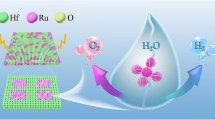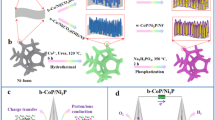Abstract
Heterostructure engineering holds exceptional promise for the development of high-performance electrocatalysts for overall water splitting. However, production of inexpensive and high-efficiency bifunctional electrocatalysts remains a challenge. Herein, we demonstrate a simple method to synthesize a paper-mulberry (Broussonetia papyrifera)-in-spired Co9S8@CoNi2S4/nickel foam (Co9S8@CoNi2S4/NF) heterojunction with high catalytic activity and stability. The process involves in situ growth of NiCo layered double hydroxide and in situ derivatization of ZIF-67, followed by the S heteroatom doping. The Co9S8@CoNi2S4/NF benefits from the heterostructure and functional advantages of multidimensional building blocks including one-dimensional (1D) nanowires, 2D nanosheets and nanoparticles. The optimized Co9S8@CoNi2S4/NF heterojunction with 10% sulphur content reveals excellent electrocatalytic activity with the lower over-potentials of 68 mV for hydrogen evolution reaction (HER) and 170 mV for oxygen evolution reaction (OER) at 10 mA cm−2 in the 1.0 mol L−1 KOH solution, which is superior to the recently reported transition metal based electrocatalysts. The outstanding performance is attributed to the strong interface coupling between CoNi2S4 and Co9S8, the advantage of multidimensional structure and the customized electronic structure. The density functional theory suggests that the interface between Co9S8 and CoNi2S4 optimizes the adsorption of the multiple intermediates and further facilitates water splitting kinetics. This work offers a generic approach for heterostructure engineering design of high-performance catalytic system applications.
摘要
异质结构工程在高效全解水催化剂方面具有突出的应用前景. 然而, 生产廉价高效的双功能电催化剂仍然是一个巨大的挑战. 因此, 我们受构树启发, 通过一种简单的方法在泡沫镍基体上合成了高催化 活性和稳定性的Co9S8@CoNi2S4/NF异质结. 该过程包括NiCo层状双氢 氧化物在泡沫镍基体上的原位生长和原位衍生ZIF-67, 并伴随S原子掺 杂. 所获得的Co9S8@CoNi2S4/NF多维度异质结包括一维纳米线、二维 纳米片和纳米颗粒. 优化的Co9S8@CoNi2S4/NF中硫含量为10%, 在 1.0 mol L−1KOH溶液中, 电流密度为10 mA cm−2时, 具有优异的电催化 活性, 其析氢和析氧过电位分别为68和170 mV, 优于最近报道的过渡金 属基电催化剂. 该催化剂优异的催化性能主要归因于CoNi2S4与Co9S8之 间较强的界面耦合、多维结构以及定制电子结构优势. 密度泛函理论 表明, Co9S8和CoNi2S4之间的界面优化了多个中间体的吸附, 进一步促 进了水裂解动力学. 本工作为高效异质结构工程催化体系的设计提供 了一种通用的方法.
Similar content being viewed by others
References
Ren JT, Wang YS, Chen L, et al. Binary FeNi phosphides dispersed on N,P-doped carbon nanosheets for highly efficient overall water splitting and rechargeable Zn-air batteries. Chem Eng J, 2020, 389: 124408
Wang HY, Weng CC, Ren JT, et al. An overview and recent advances in electrocatalysts for direct seawater splitting. Front Chem Sci Eng, 2021, 15: 1408–1426
Hou J, Wu Y, Zhang B, et al. Rational design of nanoarray architectures for electrocatalytic water splitting. Adv Funct Mater, 2019, 29: 1808367–1808405
Gao WK, Yang M, Chi JQ, et al. In situ construction of surface defects of carbon-doped ternary cobalt-nickel-iron phosphide nanocubes for efficient overall water splitting. Sci China Mater, 2019, 62: 1285–1296
Ren JT, Yao Y, Yuan ZY. Fabrication strategies of porous preciousmetal-free bifunctional electrocatalysts for overall water splitting: Recent advances. Green Energy Environ, 2021, 6: 620–643
Lu SS, Zhang LM, Dong YW, et al. Tungsten-doped Ni-Co phosphides with multiple catalytic sites as efficient electrocatalysts for overall water splitting. J Mater Chem A, 2019, 7: 16859–16866
Li Y, Tan X, Hocking RK, et al. Implanting Ni-O-VOx sites into Cudoped Ni for low-overpotential alkaline hydrogen evolution. Nat Commun, 2020, 11: 2720
Xu SS, Lv XW, Zhao YM, et al. Engineering morphologies of cobalt oxide/phosphate-carbon nanohybrids for high-efficiency electrochemical water oxidation and reduction. J Energy Chem, 2021, 52: 139–146
Chen W, Zhu X, Zhang Y, et al. Bimetal-organic frameworks from in situ-activated NiFe foam for highly efficient water splitting. ACS Sustain Chem Eng, 2021, 9: 1826–1836
Zheng X, Cui P, Qian Y, et al. Multifunctional active-center-transferable platinum/lithium cobalt oxide heterostructured electrocatalysts towards superior water splitting. Angew Chem Int Ed, 2020, 59: 14533–14540
Wang Y, Yan D, El Hankari S, et al. Recent progress on layered double hydroxides and their derivatives for electrocatalytic water splitting. Adv Sci, 2018, 5: 1800064–1800096
Liu H, Zhu J, Li Z, et al. Fe2O3/N doped rGO anode hybridized with NiCo LDH/Co(OH)2 cathode for battery-like supercapacitor. Chem Eng J, 2021, 403: 126325
Wang F, He P, Li Y, et al. Interface engineered WxC@WS2 nanostructure for enhanced hydrogen evolution catalysis. Adv Funct Mater, 2017, 27: 1605802–1605808
Liu H, Ma X, Rao Y, et al. Heteromorphic NiCo2S4/Ni3S2/Ni foam as a self-standing electrode for hydrogen evolution reaction in alkaline solution. ACS Appl Mater Interfaces, 2018, 10: 10890–10897
Zhao L, Jia J, Yang Z, et al. One-step synthesis of CdS nanoparticles/MoS2 nanosheets heterostructure on porous molybdenum sheet for enhanced photocatalytic H2 evolution. Appl Catal B-Environ, 2017, 210: 290–296
Wu Y, Liu X, Han D, et al. Electron density modulation of NiCo2S4 nanowires by nitrogen incorporation for highly efficient hydrogen evolution catalysis. Nat Commun, 2018, 9: 1425
Wang B, Chen Y, Wang X, et al. rGO wrapped trimetallic sulfide nanowires as an efficient bifunctional catalyst for electrocatalytic oxygen evolution and photocatalytic organic degradation. J Mater Chem A, 2020, 8: 13558–13571
Zhao Y, Mavrokefalos CK, Zhang P, et al. Self-templating strategies for transition metal sulfide nanoboxes as robust bifunctional electrocatalysts. Chem Mater, 2020, 32: 1371–1383
Tian WW, Ren JT, Lv XW, et al. In situ sulfidation for controllable heterointerface of cobalt oxides-cobalt sulfides on 3D porous carbon realizing efficient rechargeable liquid-/solid-state Zn-air batteries. ACS Sustain Chem Eng, 2021, 9: 510–520
Jin L, Xu H, Wang C, et al. Multi-dimensional collaboration promotes the catalytic performance of 1D MoO3 nanorods decorated with 2D NiS nanosheets for efficient water splitting. Nanoscale, 2020, 12: 21850–21856
Wang P, Qi J, Li C, et al. Hierarchical CoNi2S4@NiMn-layered double hydroxide heterostructure nanoarrays on superhydrophilic carbon cloth for enhanced overall water splitting. Electrochim Acta, 2020, 345: 136247
An T, Wang Y, Tang J, et al. Interlaced NiS2-MoS2 nanoflake-nanowires as efficient hydrogen evolution electrocatalysts in basic solutions. J Mater Chem A, 2016, 4: 13439–13443
Zhang X, Jin M, Lian Q, et al. Ion modification of transition cobalt oxide by soaking strategy for enhanced water splitting. Chem Eng J, 2021, 423: 130218
Han S, Chen Y, Hao Y, et al. Multi-dimensional hierarchical CoS2@ MXene as trifunctional electrocatalysts for zinc-air batteries and overall water splitting. Sci China Mater, 2021, 64: 1127–1138
Jing C, Guo X, Xia L, et al. Morphologically confined hybridization of tiny CoNi2S4 nanosheets into S, P co-doped graphene leading to enhanced pseudocapacitance and rate capability. Chem Eng J, 2020, 379: 122305
Hou T, Jia Z, Wang B, et al. MXene-based accordion 2D hybrid structure with Co9S8/C/Ti3C2Tx as efficient electromagnetic wave absorber. Chem Eng J, 2021, 414: 128875
Jia H, Wang Z, Zheng X, et al. Interlaced Ni-Co LDH nanosheets wrapped Co9S8 nanotube with hierarchical structure toward high performance supercapacitors. Chem Eng J, 2018, 351: 348–355
Zhu H, Jiang R, Chen X, et al. 3D nickel-cobalt diselenide nanonetwork for highly efficient oxygen evolution. Sci Bull, 2017, 62: 1373–1379
Zou Z, Wang X, Huang J, et al. An Fe-doped nickel selenide nanorod/nanosheet hierarchical array for efficient overall water splitting. J Mater Chem A, 2019, 7: 2233–2241
Wang ZJ, Li MX, Yu JH, et al. Low-iridium-content IrNiTa metallic glass films as intrinsically active catalysts for hydrogen evolution reaction. Adv Mater, 2020, 32: 1906384
Dong B, Xie JY, Wang N, et al. Zinc ion induced three-dimensional Co9S8 nano-neuron network for efficient hydrogen evolution. Renew Energy, 2020, 157: 415–423
Qin JF, Yang M, Chen TS, et al. Ternary metal sulfides MoCoNiS derived from metal organic frameworks for efficient oxygen evolution. Int J Hydrogen Energy, 2020, 45: 2745–2753
Qu S, Huang J, Yu J, et al. Ni3S2 nanosheet flowers decorated with CdS quantum dots as a highly active electrocatalysis electrode for synergistic water splitting. ACS Appl Mater Interfaces, 2017, 9: 29660–29668
Zhang Q, Chen W, Chen G, et al. Bi-metallic nitroxide nanodot-decorated tri-metallic sulphide nanosheets by on-electrode plasma-hydrothermal sprouting for overall water splitting. Appl Catal B-Environ, 2020, 261: 118254
Qu S, Chen W, Yu J, et al. Cross-linked trimetallic nanopetals for electrocatalytic water splitting. J Power Sources, 2018, 390: 224–233
Liu T, Asiri AM, Sun X. Electrodeposited Co-doped NiSe2 nanoparticles film: A good electrocatalyst for efficient water splitting. Nanoscale, 2016, 8: 3911–3915
Cai Z, Wu A, Yan H, et al. Hierarchical whisker-on-sheet NiCoP with adjustable surface structure for efficient hydrogen evolution reaction. Nanoscale, 2018, 10: 7619–7629
Lin Y, Pan Y, Liu S, et al. Construction of multi-dimensional core/shell Ni/NiCoP nano-heterojunction for efficient electrocatalytic water splitting. Appl Catal B-Environ, 2019, 259: 118039
Wen S, Chen G, Chen W, et al. Nb-doped layered FeNi phosphide nanosheets for highly efficient overall water splitting under high current densities. J Mater Chem A, 2021, 9: 9918–9926
Hou J, Sun Y, Cao S, et al. Graphene dots embedded phosphide nanosheet-assembled tubular arrays for efficient and stable overall water splitting. ACS Appl Mater Interfaces, 2017, 9: 24600–24607
Yu L, Zhou H, Sun J, et al. Cu nanowires shelled with NiFe layered double hydroxide nanosheets as bifunctional electrocatalysts for overall water splitting. Energy Environ Sci, 2017, 10: 1820–1827
Wang JG, Hua W, Li M, et al. Structurally engineered hyperbranched NiCoP arrays with superior electrocatalytic activities toward highly efficient overall water splitting. ACS Appl Mater Interfaces, 2018, 10: 41237–41245
Chen W, Zhang Y, Huang R, et al. Ni-Co hydroxide nanosheets on plasma-reduced Co-based metal-organic nanocages for electrocatalytic water oxidation. J Mater Chem A, 2019, 7: 4950–4959
Zhang Q, Chen W, Chen G, et al. Trimetallic octahedral Ni-Co-W phosphoxide sprouted from plasma-defect-engineered Ni-Co support for ultrahigh-performance electrocatalytic hydrogen evolution. ACS Sustain Chem Eng, 2021, 9: 7454–7465
Wang C, Zhu M, Cao Z, et al. Heterogeneous bimetallic sulfides based seawater electrolysis towards stable industrial-level large current density. Appl Catal B-Environ, 2021, 291: 120071
Acknowledgements
This work was supported by the National Natural Science Foundation of China (22005273, 21825106, and 21671175) and the Program for Science & Technology Innovative Research Team in the University of Henan Province (20IRTSTHN007). Ostrikov K thanks the Australian Research Council and QUT Centre for Materials Science for partial support.
Author information
Authors and Affiliations
Contributions
Chen W designed and engineered the samples; Chen W analyzed the data and wrote the paper with the support from Zang SQ; Hu Y conducted the theoretical simulation; Cui J and Wang J performed the experiments; Ostrikov K and Peng P helped to revise and polish the paper; Wei W and Zhang Y helped to conduct some characterizations. All authors contributed to the general discussion.
Corresponding author
Additional information
Conflict of interest
The authors declare that they have no conflict of interest.
Supplementary information
Supporting data are available in the online version of the paper.
Shuang-Quan Zang received his PhD degree in chemistry from Nanjing University in 2006 under the supervision of Prof. Qingjin Meng. After postdoctoral research with Prof. Thomas C. W. Mak at The Chinese University of Hong Kong, he joined the College of Chemistry, Zhengzhou University. He received the National Science Fund for Distinguished Young Scholars in 2018. He is serving as the Dean of the College of Chemistry and Green Catalysis Center, Zhengzhou University. His current scientific interests focus on atomically-precise metal clusters, cluster-assembled materials, and functional metal-organic frameworks.
Rights and permissions
About this article
Cite this article
Chen, W., Hu, Y., Peng, P. et al. Multidimensional Ni-Co-sulfide heterojunction electrocatalyst for highly efficient overall water splitting. Sci. China Mater. 65, 2421–2432 (2022). https://doi.org/10.1007/s40843-021-1994-8
Received:
Accepted:
Published:
Issue Date:
DOI: https://doi.org/10.1007/s40843-021-1994-8




